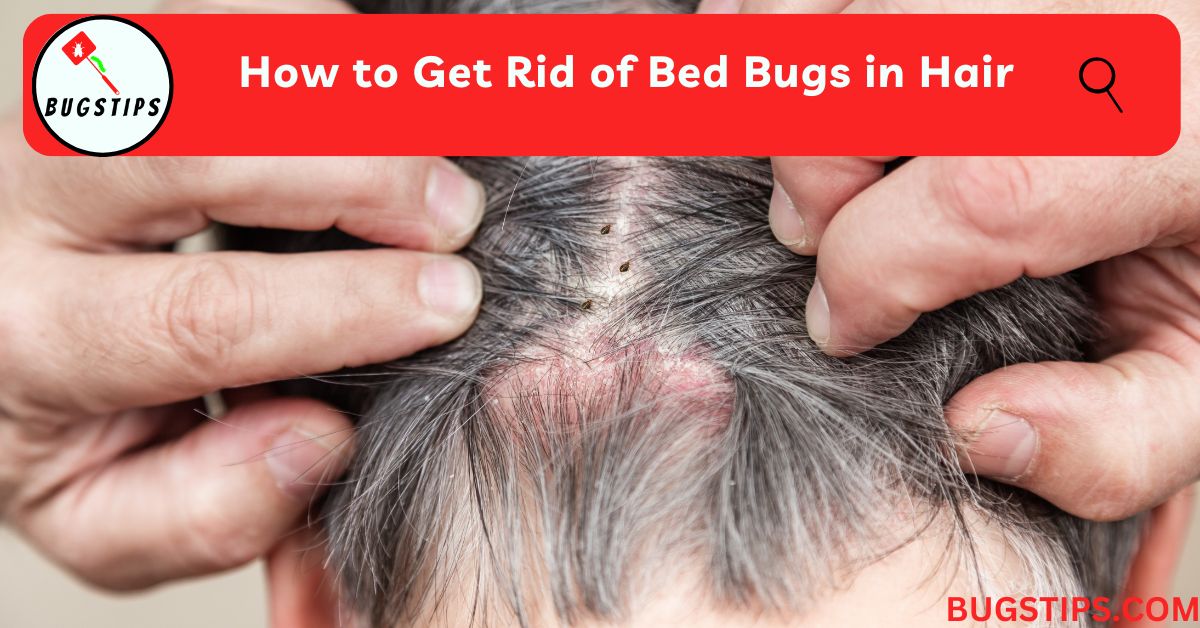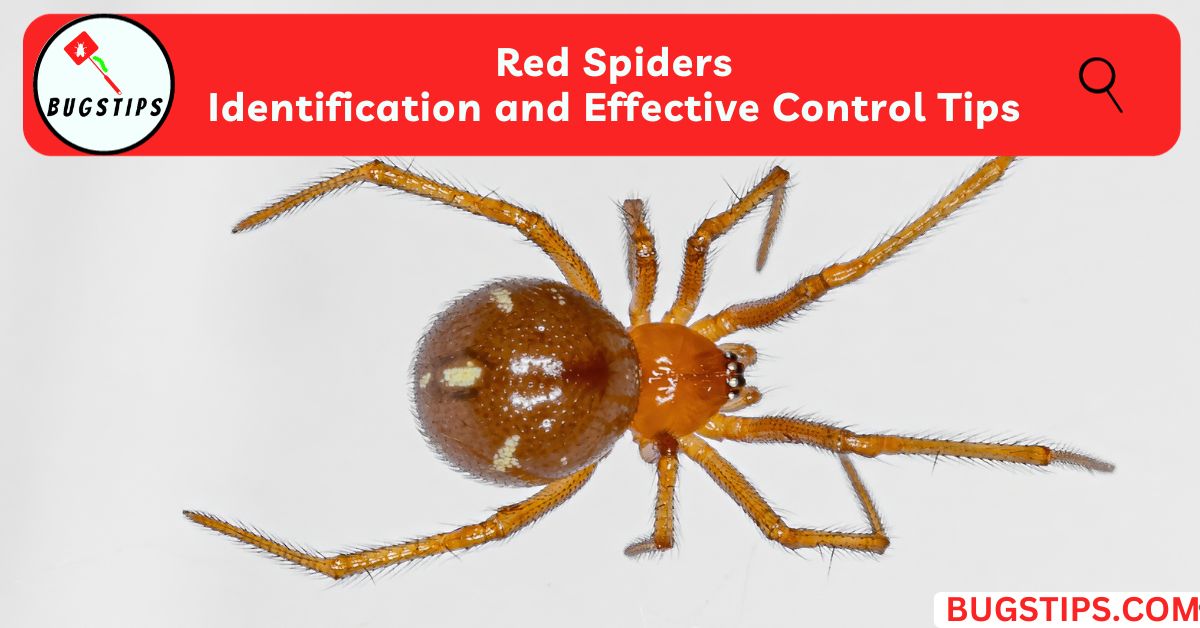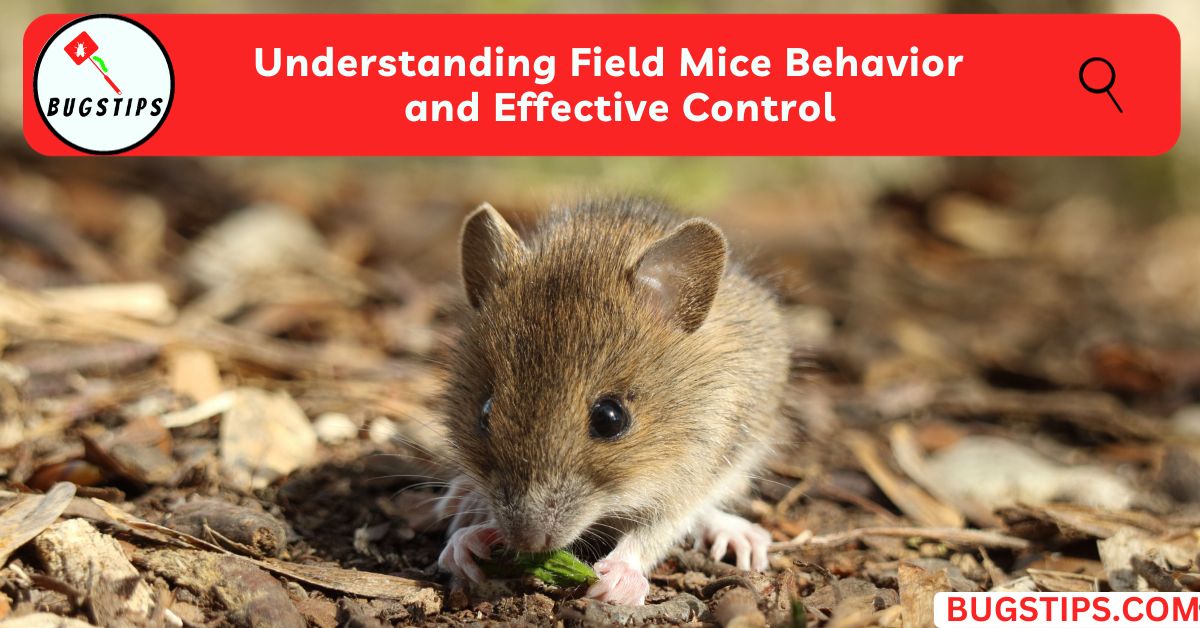This post may contain affiliate links which means as an Amazon Associate, this site may earn a small commission on qualified purchases made through links at no extra cost to you. Learn more on Affiliate Disclosure
Banana spiders are colorful and fascinating arachnids that can often be found resting in their intricate webs woven among banana plants.
Their name comes from this close association with banana crops and trees.
But are banana spiders poisonous? This is a common question for anyone encountering these giant spiders and their impressive golden webs while harvesting bananas.
The short answer is – it depends. There are a few different types of spiders referred to as banana spiders, and only some of these species are venomous to humans.
In this article, we’ll uncover facts about the various kinds of banana spiders, examine which ones have dangerous bites, and learn how to identify them.
We’ll also discuss what to do if you suffer a banana spider bite. By the end, you’ll have a clear understanding of whether banana spiders pose a poisonous risk or not.
You May Also Like – Do Wolf Spiders Make Webs?
Types of Banana Spiders
Before we dive into the question of banana spider toxicity, it’s helpful to understand the different types of spiders that fall under the banana spider label.
There are several species referred to as banana spiders, each boasting its own set of intriguing traits and physical features.
Getting familiar with their distinguishing characteristics will make it easier to identify any banana spider you encounter.
There are 4 main types of spiders known as banana spiders.
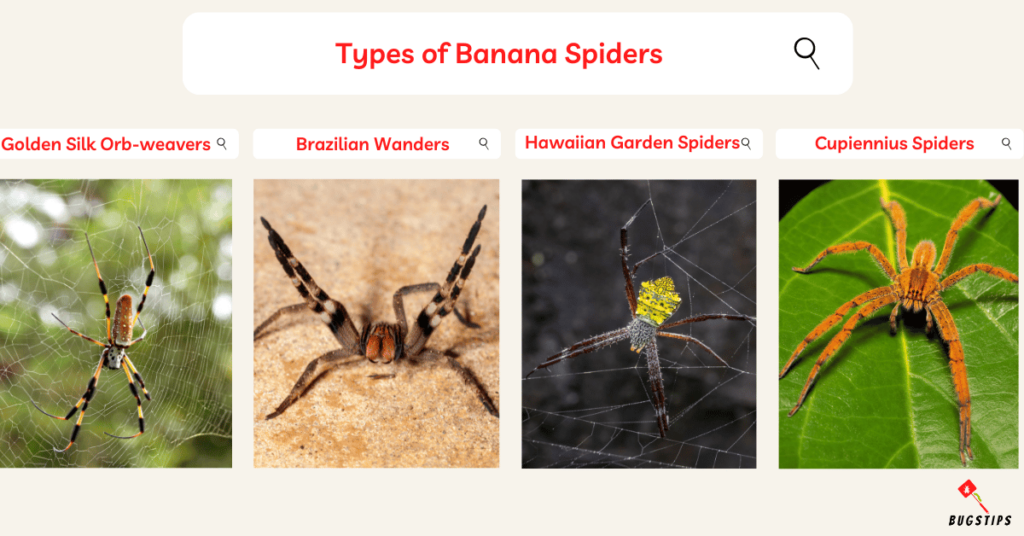
Golden Silk Orb-weaver Spiders
- The golden silk orb-weaver is probably the most dazzling and recognizable banana spider species.
- These spiders come in vibrant colors with yellow and brown patterned bodies and banded legs.
- The size of the Golden Silk Orb-weaver spider can vary depending on gender. Females reach 5 inches (13 cm) in body length. The males are quite a bit smaller.
- They’re absolute masters at building enormous, wheel-shaped webs that can reach up to 3 feet wide! Their webs have beautiful golden silk, which gives this spider its name.
- You can find these web artisans in tropical and subtropical areas of the Americas hanging out in banana groves.
Brazilian Wandering Spiders
- Brazilian wandering spiders stand out for being large, fuzzy spiders with bodies up to 2 inches long covered in hairs.
- Their colors range from dark brown to black with faint striping on their long legs.
- These spiders live up to their name – they actively wander the jungle floor hunting rather than building webs.
- They’re found in South and Central America and are infamous for their aggressive behavior.
- If you disturb one, it’ll stand its ground and pose to attack!
Hawaiian Garden Spider
- As the name suggests, the Hawaiian Garden Spider graces the lush landscapes of the Hawaiian Islands.
- These arachnids are characterized by their vibrant and intricate web patterns, resembling delicate artwork.
- Their color palette often features vibrant hues of yellow, black, and white, adding a touch of tropical elegance to their surroundings.
- These spiders have remarkable patience as they wait for unsuspecting prey to become ensnared in their beautifully woven traps.
Cupiennius Spiders
- The Cupiennius spiders, also known as the Bromeliad spiders, exhibit a graceful nature as they navigate the foliage of various tropical habitats.
- These spiders are known for their agility and keen hunting instincts.
- With their size varying from small to moderate, they are skilled climbers that often inhabit plants like bromeliads.
- Their camouflage abilities make them adept at blending into their surroundings, creating an air of mystery as they seek their next meal.
You May Also Like – Zombie Spiders | The Creepy Truth
Are Banana Spiders Poisonous?
It really depends on the type you’re dealing with. Some banana spiders definitely pack a poisonous punch, while others are completely harmless to us humans.
The Brazilian wandering spider is the one with the reputation for being the most venomous.
This big, hairy spider has some incredibly potent neurotoxic venom that can cause severe injury and even death in very rare cases.
So it’s fair to say this banana spider lives up to its dangerous, intimidating image.
On the flip side, the colorful golden silk orb-weaver you’ll see weaving beautiful golden webs in banana trees has a very mild venom.
Its bite might hurt a bit, but it’s nothing worse than a bee sting for us. So even though they look imposing, you don’t need to fear any poison from them.
The same goes for the Hawaiian garden spider and its funky black and yellow patterned legs.
These docile spiders have a venom that barely registers on human skin. They’re perfectly harmless despite their iconic looks.
So, the Brazilian wandering spider deserves every bit of its deadly reputation, most other types of banana spiders don't pose any real poison threat to people.
Related Article – Are Woodlouse Spiders Poisonous?
What Happens if a Banana Spider Bites You?
What actually happens if you have the misfortune of getting bitten by one of these spiders?
If you are bitten by a banana spider, the symptoms you experience will depend on the type of banana spider behind the bite.
While such encounters might be rare, it’s essential to understand the potential outcomes if you ever find yourself on the receiving end of a banana spider bite.
Symptoms of a Banana Spider Bite
| Spider Species | Symptoms |
|---|---|
| Golden Orb-weaver | Mild localized pain and burning at the bite site Some minor swelling and redness around the bite Itching or tingling sensation No serious effects; symptoms disappear within a few hours |
| Brazilian Wandering Spider | Immediate excruciating pain at the bite location Nausea, abdominal cramping, and excessive sweating/salivation Muscle spasms, tremors, weakness, and coordination issues Blurred vision, dizziness, slurred speech Breathing difficulties in severe cases Potentially lethal without medical treatment |
| Hawaiian Garden Spider | Brief pinching or prickly feeling when bitten Little to no residual pain or effects afterward Very minimal local reaction; no tissue damage |
| Cupiennius Spiders | Instant sharp pain, similar to a bee sting Muscle cramping and stiffness near the bite site Achy discomfort that persists for a few hours Occasional headache, nausea, or dizziness |
So in the majority of cases, a banana spider bite leads to temporary discomfort at worst.
Only the Brazilian wanderer can inflict severely toxic effects, making it the outlier. Knowing which species bit you dictate just how concerned you need to be about poisonous consequences.
You May Also Like – Does Lavender Repel Spiders?
First Aid Measures to Take After a Banana Spider Bite
Getting bitten by any spider can be an unsettling experience. but there’s no need to panic.
Here are some recommended first aid measures if you are bitten by a banana spider.

Clean the Area
- As soon as you notice the bite, gently clean the affected area with mild soap and water.
- This helps remove any dirt or bacteria that might have come into contact with the bite.
Apply a Cold Compress
- To alleviate discomfort and reduce swelling, apply a cold compress to the bite area.
- This can be a cloth soaked in cold water or an ice pack wrapped in a thin cloth.
- Remember to avoid placing ice directly on the skin to prevent frostbite.
Take Over-the-Counter Pain Relievers
- If you’re experiencing pain, over-the-counter pain relievers like ibuprofen or acetaminophen can be taken according to the recommended dosage.
- This can help ease any discomfort you might be feeling.
Avoid Scratching & Elevate
- Itching can be a common side effect of spider bites, including those from banana spiders.
- As tempting as it might be, avoid scratching the bite area to prevent potential infection.
- Keep the bitten limb elevated above heart level when possible to slow venom absorption. Try not to move the limb excessively.
If you're bitten by a Brazilian wandering spider and experience muscle spasms, numbness, respiratory issues, or any other concerning symptoms after the bite, seeking emergency medical care is crucial.
Related Article – Does Windex Kill Spiders? An Expert Analysis
Are Banana Spiders Good to Have Around?
When you stumble upon a large banana spider lurking in its web, your first instinct may be to get rid of it as soon as possible.
But are these spiders really pests that need to be eliminated?
Surprisingly, most banana spider species provide benefits that make them helpful to have around.
Even though we’ve covered how certain banana spiders like the Brazilian wandering spider can be highly venomous, many other banana spider species are harmless and provide advantages.
Here are some reasons why banana spiders can be considered good for your property.
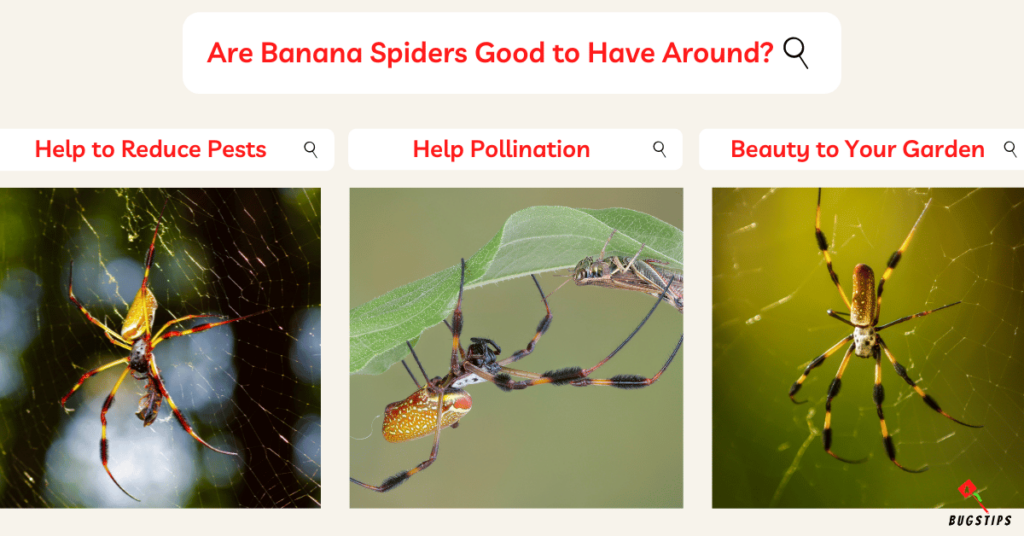
Pest Control
- Banana spiders prey on insects like mosquitoes, cockroaches, flies and moths, helping keep pest populations in check. Their webs also trap other bugs.
- By acting as natural pest predators, banana spiders may decrease reliance on chemical bug sprays.
Help Pollination
- Some banana spiders end up inadvertently helping pollinate flowers and plants when they visit blooms in search of insect prey to eat.
- Their movements among the flowers can transfer pollen from one bloom to another.
Beauty to Your Garden
- The magnificent large golden webs created by orb-weaver banana spiders can add a unique natural artistry and aesthetic when sprawled across gardens.
- Their intricate designs and golden hues provide architectural beauty.
Of course, exercising caution around venomous species like the Brazilian wandering spider is advised. But in most cases, banana spiders do not threaten humans so you can keep them in your backyard.
You May Also Like – Bugs in Mailbox: 10 EASY Ways to Keep Them Out
Final Thoughts
While the notoriously toxic Brazilian wandering spider lives up to its fearful reputation, the majority of banana spider species are not medically threatening to humans.
Yes, banana spiders may look intimidating and there are a select few with highly potent venom. But most are harmless arachnids simply going about their lives and providing valuable ecosystem services like pest control.
With sensible precautions such as leaving them be, not touching their intricate webs, wearing gloves when gardening, and being able to identify dangerous species, we can safely appreciate banana spiders from afar.
Their dazzling webs, pest-fighting skills, and important place in nature’s complex web make banana spiders admirable backyard inhabitants.
FAQs
What does a banana spider bite look like?
A banana spider bite usually appears as a red, swollen area with localized discomfort and itching.
What season do banana spiders come out?
Banana spiders tend to emerge during the warmer seasons of spring and summer when their environment becomes more favorable.
Is a banana spider a tarantula?
No, banana spiders are not tarantulas. They belong to a different group known as orb-weaver spiders
Why are banana spider webs yellow?
Banana spider webs are yellow due to the unique properties of their silk, which reflects light in a way that creates a yellowish hue.
Why do banana spiders shake their webs?
Banana spiders shake their webs to detect vibrations caused by prey or potential threats. It helps them assess their surroundings.
How long do banana spiders live?
On average, banana spiders can live for about a year, depending on factors like their environment and access to food.
Do banana spiders have hair?
Yes, banana spiders have fine hair-like structures on their bodies, which help them sense their surroundings.
How big do banana spiders get?
Banana spiders typically range in size from 1 to 5 inches, with females being larger than males.
Will a banana spider jump at you?
No, banana spiders do not jump. They are more likely to retreat or shake their webs if they feel threatened.
Can a banana spider bite kill you?
No, a banana spider bite is not fatal to humans. Their venom is not potent enough to cause serious harm.
What should I do if I get bitten by a banana spider?
Clean the area with soap and water, apply a cold compress, and monitor for any allergic reactions. Seek medical attention if symptoms worsen.
Is there a cure for a banana spider bite?
There is no specific “cure,” but first aid measures can help alleviate discomfort and reduce symptoms. Seek medical help if needed.
Resources – (for further reading)
WebMD – What to Know About Banana Spiders
Wikipedia – Phoneutria nigriventer

